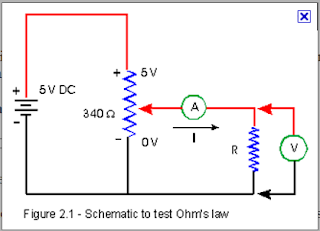The amount of current that flows through a circuit and the amount of energy transferred to any useful devices is dependant on the potential difference of the power supply and the nature of the pathway through the loads that use the potential energy.
The more difficult a path is, the more opposition to the flow there will be. The measure of this opposition is called the electrical resistance.
Resistance = Voltage / Current or R= V / I
The measure of resistance of a substance is called the resistivity. It has units called the ohm.
Resistance depends on a conductors' length, cross-sectional area, the material it is made of, and its temperature:
- A larger cross-sectional area of a conductor offers less resistance to the charge flow.(If the cross section is doubled, then the resistance goes to half of its original value.)
- A longer conductor has greater resistance than a shorter one. (If length is doubled, then the resistance is also doubled.)
- Generally an increase of temperature of a conductor, usually contributes to an increase in the resistance but not for all substances.
In a series circuit the loads are connected one after the other.
In a parallel circuit the loads are connected side by side.
In any circuit, there is not net gain or net loss of energy.
Resources:
Ohm's Law and Resistor Circuits
Ohm's Law
More on Ohm's Law

No comments:
Post a Comment